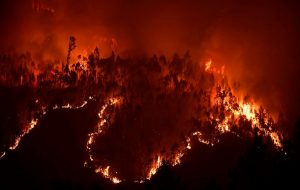By Imalka Nilmalgoda
In 2020, youth climate activists from Portugal filed a case, Youth for Climate Justice v. Austria, et al., with the European Court of Human Rights (ECtHR) against 33 countries in the European Union. They argue that the countries’ failure to mitigate climate change by committing to more ambitious emissions reductions targets violates Articles 2 (right to life), 8 (right to respect for family and private life) and 14 (prohibition on discrimination) of the European Convention on Human Rights. The case, which comes on the heels of Portugal’s worst wildfire season to date, emphasizes the increased risks of future catastrophic events due to state failure to act on climate change.

[2017 wildfires in Portugal were among the most devastating the country had ever seen. Youth activists in Portugal argue that these wildfire events will get worse if climate change is not effectively addressed. Photo by Miguel Riopa.]
Youth for Climate Justice v. Austria, et al. will be the first climate change case heard by the European Court of Human Rights – a precedent-setting moment in in the emerging arena of international climate litigation. The Court recently granted the youth an expedited hearing, suggesting the Court may also view climate change as an urgent matter. The case presents an interesting opportunity to examine climate change litigation through not only human rights law, but also the law of state responsibility.
What is the law of state responsibility?
State responsibility is a foundational principle of international law that dictates how and when a state will be held responsible for a breach of international law. There are four base concepts of state responsibility: breach, attribution, consequences and reparations. According to state responsibility, a breach of international law by a state must lead to consequences and reparations. The generality of the law of state responsibility makes it broadly applicable to a wide array of state obligations.
In 2001, these four base concepts were examined and codified by the International Law Commission (ILC) into what is now known as the Articles on the Responsibility of States for Internationally Wrongful Acts (“ARSIWA” or “the Articles”). International human rights law had a significant impact on the development of ARSIWA, as seen in the ILC’s commentary to earlier versions of the Articles, which drew heavily on international human rights cases. The European Court of Human Rights has also repeatedly affirmed in its judgments and decisions that ARSIWA codifies the principles of state responsibility, indicating it is an important legal consideration in international human rights cases.
Does the law of state responsibility apply to climate change?
Some scholars argue that the law on state responsibility is flexible enough to be applied in the context of climate change and international human rights law.[1] This is in part due to the generality of its application and in part due to the ability to apply ARSIWA to erga omnes obligations, which are obligations owed to every individual, community or state. When a state violates treaties or bilateral/multilateral agreements it has signed, it violates international law.
In 1992, 165 countries signed The United Nations Framework Convention on Climate Change (UNFCCC) agreeing to commit to efforts to stabilize greenhouse gas concentrations in the atmosphere. In 2016, 195 countries ratified the Paris Agreement, a treaty requiring states to use their best efforts to reduce emissions according to the global 1.5 degrees Celsius warming target. Both of these treaties created obligations on the signatory states and where these obligations are not met, state responsibility should ensue.

[World leaders at COP21, which resulted in the Paris Agreement. A binding agreement signed by 195 state parties in 2016, the Paris Agreement represents a landmark treaty on international climate cooperation. Photo by Guillaume Horcajuelo.]
Other scholars claim state responsibility can result from the “no harm” principle in international environmental law.[2] This principle, recognized as a rule of customary international law, requires states to not engage in activities that cause transboundary environmental damage. As stated by former UN Secretary General Ban-Ki Moon, “climate change carries no passport; emissions released anywhere contribute to the problem everywhere.” Considering that the human rights of every individual are affected in some way by climate change resulting from greenhouse gas emissions, the “no harm” principle implies states have a duty owed to the international community as a whole. An act, or omission, therefore, of a state that violates the “no harm” principle can trigger state responsibility under ARSIWA.
Harmful greenhouse gas emissions from industry lead to climate change and negatively impact the rights to life, health, food, water and sanitation, housing, culture, and self-determination. Given the severity of harm resulting from greenhouse gas emissions, as well as the transboundary nature of the harm, international human rights lawyers can use ARSIWA to argue that states are responsible for continuing legal violations of climate change treaties.
The Portuguese youth still face hurdles in Youth for Climate Justice v. Austria, et al., including the question of whether they must “exhaust domestic remedies” before the ECtHR will hear their case. However, because only a small percentage of cases make it to the stage where they will be heard on the merits, the Court’s fast-tracking of this case has all eyes on Strasbourg. The question now is whether regional human rights courts, such as the ECtHR, are the right venue for protecting future generations against the increasingly devastating harm of climate change, which impacts us all.
Imalka Nilmalgoda is a 3L student at the Peter A. Allard School of Law working with the IJHR Clinic as part of the Environment Team.
[1] Margaretha Wewerinke-Singh, “The Law of State Responsibility” in State Responsibility, Climate Change and Human Rights Under International Law (Oxford: Hart Publishing).
[2] Benoit Mayer, “State Responsibility and Climate Change Governance: A light through the Storm” (2014) Chinese Journal of International Law 539.